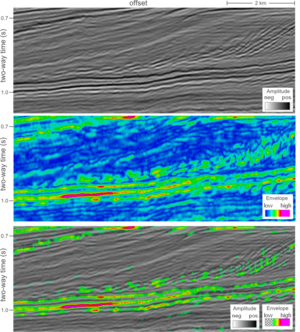E is for Envelope 2
/ This seismic profile offshore Netherlands is shown three ways to illustrate the relationship between amplitude and envelope, which we introduced yesterday.
This seismic profile offshore Netherlands is shown three ways to illustrate the relationship between amplitude and envelope, which we introduced yesterday.
The first panel consists of seismic amplitude values, the second panel is the envelope, and the third panel is a combination of the two (co-rendered with transparency). I have given them different color scales because amplitude values oscillate about zero and envelope values are always positive.
The envelope might be helpful in this case for simplifying the geology at the base of the clinoforms, but doesn't seem to provide any detail along the high relief slopes.
It also enhances the bright spot in the toesets of the clinoforms, but, more subtly, it suggests that there are 3 key interfaces, out of a series of about 10 peaks and troughs. Used in this way, it may help the interpreter decide which reflections are important, and which reflections are noise (sidelobe).
Another utility of envelope is that it is independent of phase. If the maximum on the envelope does not correspond to a peak or trough on the seismic amplitudes, the seismic amplitudes may not be zero phase. In environments where phase is wandering, either pre-stack or post-stack domain, the envelope attribute is a handy accompaniment to constrain reflection picking or AVO analyses: envelope vs offset, or EVO. It also makes me wonder if adding envelopes to the modeling of synthetic seismiograms might yield better well ties?








 Except where noted, this content is licensed
Except where noted, this content is licensed